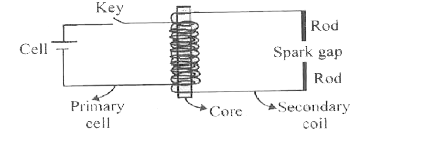Text Solution
Verified by Experts
|
Topper's Solved these Questions
ELECTROMAGNETIC INDUCTION
NEW JOYTHI PUBLICATION|Exercise CONTINUOUS EVALUATION (ASSIGNMENTS)|2 VideosView PlaylistELECTROMAGNETIC INDUCTION
NEW JOYTHI PUBLICATION|Exercise PREVIOUS YEAR QUESTIONS|2 VideosView PlaylistELECTROMAGNETIC INDUCTION
NEW JOYTHI PUBLICATION|Exercise PRACTICE PROBLEMS FOR SELF ASSESSMENT|3 VideosView PlaylistELECTRIC CHARGES AND FIELDS
NEW JOYTHI PUBLICATION|Exercise Competitive Exam Corner|20 VideosView PlaylistELECTROMAGNETIC WAVES
NEW JOYTHI PUBLICATION|Exercise COMPETITIVE EXAM CORNER|16 VideosView Playlist
Similar Questions
Explore conceptually related problems
NEW JOYTHI PUBLICATION-ELECTROMAGNETIC INDUCTION -EVALUTAION QUESTIONS AND ANSWERS
- A solenoid with large number of turns is in a closed circuit and a sho...
06:17
|
Play - A rectangular closed loop moves horizontally in a uniform magnetic fie...
03:32
|
Play - a. How is the flux linkage through a coil related to current? b. Wha...
03:26
|
Play - The induced emf is sometimes called back emf. Why?
02:53
|
Play - Why is spark produced in the switch of a fan when it is switched off?
01:33
|
Play - Fig. E.I show s magnet coil experiment of electromagnetic induction. ...
05:44
|
Play - Take a strong cylindrical electromagnet connected to AC source and pla...
04:10
|
Play - A short bar magnet is dropped through a coil of wire of similar length...
02:24
|
Play - When a metallic block moves in a magnetic field induced currents are d...
03:55
|
Play - a. Which law is demonstrated in the above figures? b. State the law....
03:05
|
Play - When the key is closed, a spark is generated between the ends of the r...
03:08
|
Playing Now - You are given a solenoid of length 'l', number of turns per unit lengt...
02:58
|
Play - Figure shows a metal rod PQ resting on the smooth rails AB and positio...
13:07
|
Play - a. Obtain an expression for the mutual inductance between a long strai...
09:49
|
Play
